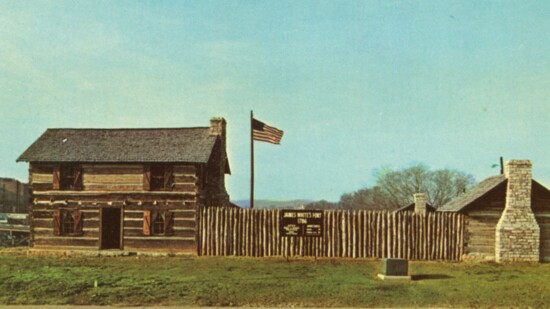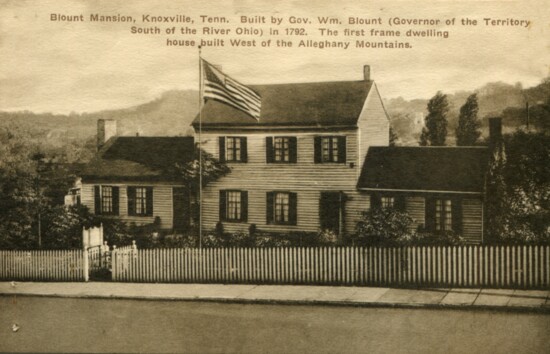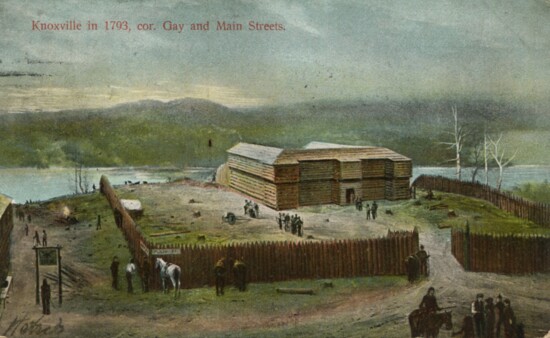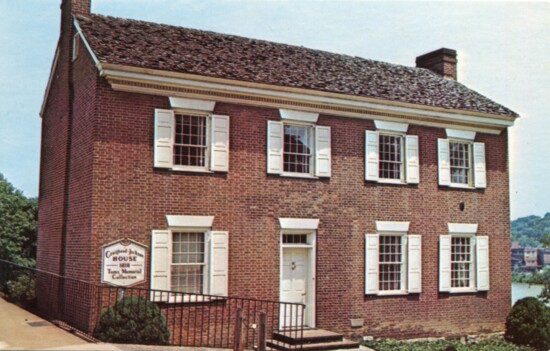At the nonprofit Knoxville History Project, we are always on the lookout for old images for our Knoxville Shoebox digital collection. If you have interesting photographs, postcards, or brochures from any era, we’d love to hear from you so we can preserve the visual history of Knoxville and make it available for researchers of the future.
This month, we highlight several postcards representing the very early days of Knoxville when it was a fledging town on the American frontier. Both James White’s Fort and Blount Mansion are a short walk from each other on East Hill Avenue along a kind of “Founder’s Row” and are must-sees for anyone wishing to know more about life during Knoxville’s formative years.
James White’s Fort
The original homestead of James White (1747-1821), a Captain of the Revolutionary War from North Carolina, officially represents the birthplace of Knoxville. White arrived in the area around 1785 and established the first permanent structure. More settlers joined him, living among several cabins within a courtyard all enclosed by a stockade fence to keep out wild animals and anyone else. Originally located about where the State Street Garage now stands adjacent to First Presbyterian Church, White’s cabin was dismantled in the early 1900s and incorporated into a suburban house on Woodlawn Pike in South Knoxville. The surviving parts of White’s cabin were rescued as part of an effort led by the City Association of Women’s Clubs to reconstruct White’s Fort on East Hill Avenue. It opened to the public in 1970.
Blount Mansion
William Blount (1749-1800), a significant land speculator from eastern North Carolina, served as the Governor of the Southwest Territory (1790 to 1796) and worked alongside James White to establish the territory’s capital here in 1791. Blount soon built his “grand” house which is widely believed to have been influenced by his strong-willed wife, Mary, with its “modern” design. Frame houses with windows were extraordinarily unusual on the frontier, so rare that visiting Cherokee reportedly called it “The House with many Eyes.” Saved from the wrecker’s ball in the 1920s when it was slated to become a parking lot for the adjacent Andrew Johnson Hotel, the mansion became the city’s first public museum and has endured as Knoxville’s only National Historic Landmark.
Federal Blockhouse
When Knoxville was founded in 1791, William Blount named it after his immediate superior, Gen. Henry Knox, then Secretary of War under President George Washington. Although Knox never visited here, Blount may have hoped his choice of name would afford the new town some protection. In any case, a federal garrison and blockhouse were established on top of the bluff above the river, the site is now occupied by the old Knox County courthouse. It was a stone’s throw from Blount’s home and existed during a time when an early visitor to Knoxville described the place as having “ten stores and seven taverns.” While the blockhouse was never attacked directly, it played a role in discouraging a potentially lethal Chickamaugan assault in 1793. This speculative scene was painted a century later around 1900 by artist Lloyd Branson, who is regarded by many as Knoxville’s first professional artist.
Craighead-Jackson House
Adjacent to Blount Mansion on an old remnant of State Street that once ran down to the river is the Craighead-Jackson house dating to about 1818. It’s named after John and Temperance Craighead, who had connections to pioneer families such as the Whites and the Ramseys. The house is believed to have been built using bricks hand-made by enslaved workers belonging to the family. Notably, Knoxville Mayor William Swan lived here briefly in the 1850s before it was owned for several decades by physician George Jackson. Numerous owners followed over the years until it was purchased by the City of Knoxville in 1957. It later served as a visitor center for Blount Mansion. The house and gardens have recently been restored.
ABOUT KHP
The mission of the Knoxville History Project (KHP) is to research, preserve, and promote the history and culture of Knoxville, Tennessee. Through research and engaging programs, KHP tells the city’s stories, focusing on those that have not been previously told and those that connect the city to the world. KHP’s stories, programs, and publications educate and help residents and visitors understand the city’s past and its complicated but dynamic heritage, and also inspire an appreciation for the city’s culture.
Donations to support the work of the Knoxville History Project, an educational nonprofit, are always welcome and appreciated. KHP’s best-seller, Historic Knoxville: The Curious Visitor’s Guide and the latest collection of stories, Knoxville Lives V, is available at KnoxvilleHistoryProject.org, East Tennessee History Center, and Union Ave Books. To get in touch, please contact us at (865) 337-7723 or email Paul@knoxhistoryproject.org.



